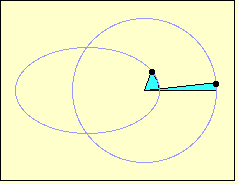 Kepler's First Law: Planets move in ellipses with the Sun at one focus.
Kepler's First Law: Planets move in ellipses with the Sun at one focus.
Kepler's First Law has applied to space scientists and astronomers since it was discovered over 430 years ago. Yet, Johannes Kepler didn't gather much of the data upon which he based his discoveries. Kepler was nearly blinded by smallpox before he was five years old.
As the Imperial Mathematician to the Holy Roman Emporer, Kepler couldn't quite see the stars he decribed in his first book, Astronomia Nova (1609), but he had faith in the measurements and in the observations of Tycho Brahe, his first patron and the man who generated much of the data for Kepler's initial insights.
Because of his eyesight, Kepler relied on Tycho Brahe's measurements of the stars and was able to derive equations that described the motion of the planets around the Sun. Keplers' Laws of Planetary Motion still hold today and are used for planning rocket launches and managing satellites in orbit. The word 'satellite' was coined by Kepler. Kepler's work is held in such esteem that he rates a page on NASA's website.
Kepler used observation and insight to create The Laws of Planetary Motion in an age before probability and computerized computation. His planetary tables... "...used logarithms, which he developed, and provided perpetual tables for calculating planetary positions for any past or future date."
Observation and insight have generated tremendous discoveries in science, indeed, the entire Scientific Method is based on intial observations, predictions, hypotheses, measurements and tests.
Observation in Physical Therapy
The temptation to adhere to observation as the basis for physical therapy discovery in patient care is strong. What can treatment-based classification (TBC) offer more than your clinical observation when you can see, hear, smell, touch, taste (?) and talk to the patient right in front of you?
Some classification predictor variables predict an outcome like spinal manipulation success with 95% confidence. But the predictor variables are themselves uncertain - derived by dumping plausible tests into a 'hopper' (derivation study) and seeing what 'falls out'.
How can these statistically derived variables compete with the observation that the patient who says "I hurt" can feel better from your hands-on care? Who gets to decide what treatment is most appropriate?
Physical therapists on Soma Simple Discussion Boards demonstrate some of the controversy around TBC.
Why is it no surprise that even accomplished physical therapists have trouble wrapping their arms around classification? Peter Huijbregts, PT talks about his struggles with this paradigm shift in the Journal of Manual and Manipulative Therapy (2007):
"The once predominant mechanism-based classification system that is based on the premise that impairments identified during examination are the cause of musculoskeletal pain and dysfunction is increasingly being replaced by treatment-based classification systems.People have always been uncomfortable with probabilistic systems, even among scientists. Some examples of probabilistic systems that have excited controversy and generated debate in the time since Kepler include the following:
In the treatment-based system, a cluster of signs and symptoms from the patient history and physical examination is used to classify patients into subgroups with specific implications for management."
- Wikipedia vs. Encyclopedia Britannica
- Free Market Economics vs. Central Planning
- The Theory of Evolution vs. Religiosity
- Google vs. what?
The Wikipedia Phenomenon (from The Long Tail)
Wikipedia articles have been described as 'amateur' or 'inaccurate'. However, a study done by the journal Nature found that Wikipedia averages 3.86 errors per article compared to 2.92 errors per article for Encyclopedia Britannica . Wikipedia article are corrected daily - as soon as the error is spotted. Encyclopedia Britannica articles only get corrected at new, printed editions - about every ten years.
Wikipedia has 13 million articles - Encyclopedia Britannica has just over 250,000. The chances that you will find an up-to-date article about something interesting in Wikipedia are pretty good. The Wikipedia article on 'Physical Therapy' is 4,659 words long. The Encyclopedia Britannica article on 'Physical Therapy' doesn't exist.
Growth Rate of Wikipedia Articles

Wikipedia is a probabilistic device that succeeds because it is useful to most of the people, most of the time. Encyclopedia Brittanica is an authoritative device that, until now, was our only option for encyclopedic information.
Authoritative Decision Makers
We still need authoritative sources like Encyclopedia Britannica but their dominance in information search is over. I recommend starting your information searches with Wikipedia and finding more authoritative sources as you delve deeper into your studies.
The ability of scientists to find amazing discoveries based on obsevation and insight has waned and so too has the dominance of physical therapists who insist that their palpatory and visual findings are superior to probabilistic tools like TBC.
Prediction of Risk
Another type of prediction physical therapists use can be called 'risk-adjusted prediction' where baseline data such as...
- age
- impairments
- self-report scores
- co-morbid factors like fear
- self-report change scores
- predicted total number of visits
- predicted total duration of care
Risk-adjustment is not as cold and calculating as it sounds. Physical therapist J.W. Matheson believes he is a better physical therapist by using this tool.
"I find great value in this information and believe that it helps improve my communication and care of my patients.For the non-mathematician/statistician (I am a 'non') it may feel like we are being asked to cede our decision-making control to algorithms and databases on 'faith'. Faith in the science and the statistics behind classification is what we fellow 'nons' are asked to trust.
We spend time during the initial evaluation discussing aspects of their risk-adjusted outcome data, and psychosocial yellow flags can be identified immediately.
More efficient care and utilization of staff and services is the end result."
(IMPACT June 2009 PPS log-in required)
What future pathways will physical therapists predict using probabilistic tools?




0 komentar:
Posting Komentar